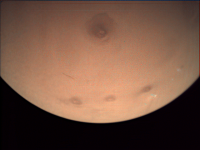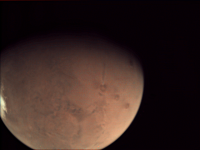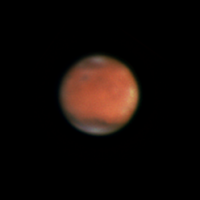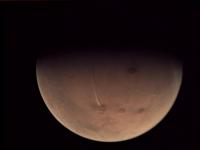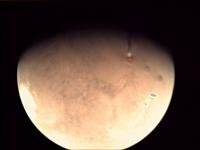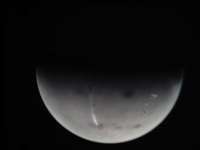Printable Version of Topic
Click here to view this topic in its original format
Unmanned Spaceflight.com _ Mars _ Arsia Mons Anomaly?
Posted by: Hungry4info Sep 25 2018, 12:02 AM
Is that a Plume on Arsia Mons?
https://scilogs.spektrum.de/go-for-launch/is-that-a-plume-on-arsia-mons/
Images of the Tharsis region show the emergence of a new prolonged feature that appears to cast a long shadow. It is not visible in this attached image from 06 August 2018.
Then we can see something newish near Arsia Mons (the vertical streak) in this image from 19 Sep 2018.
And then most striking is this image from 23 Sep 2018, where it appears that a significant shadow is cast (in the direction of the streak in the last image, admittedly).
I'm not familiar enough with Martian meteorology to know if this is just a normal occurrence, but it does look weird, at least to me. Hopefully someone will have ideas. If the answer to this is obvious then feel free to lock and/or delete the thread.
Posted by: Explorer1 Sep 25 2018, 12:16 AM
A 2015 image shows something similar, though less dramatic, from the MOM: http://www.planetary.org/multimedia/space-images/mars/arsia-mons-and-cloud-mars.html
Seems to be just an ordinary cloud...
Posted by: djellison Sep 25 2018, 12:47 AM
Just a cloud casting a shadow. It's been seen before.
Posted by: mcaplinger Sep 25 2018, 01:13 AM
Clouds around the Tharsis volcanoes have been observed since before spaceflight. The classical name of Olympus Mons, Nix Olympica or "The Snows of Olympus", refers to such clouds.
Posted by: Hungry4info Sep 25 2018, 01:35 AM
That looks pretty convincing. Thanks!
I apologise if I contributed to clutter on the forum.
Posted by: nprev Sep 25 2018, 05:07 AM
I think that it was an excellent 'teachable moment'. ![]() It's easy to forget that Mars' atmosphere, though exceedingly thin by terrestrial standards, is still capable of producing surprisingly substantial water and CO2 clouds more frequently than might otherwise be assumed.
It's easy to forget that Mars' atmosphere, though exceedingly thin by terrestrial standards, is still capable of producing surprisingly substantial water and CO2 clouds more frequently than might otherwise be assumed.
Posted by: Floyd Sep 25 2018, 10:56 PM
Hungry4info--Not clutter, a learning experience for many of us following along. As they say in another context "if you see something, say something". It could be the next blue blob.
Posted by: cndwrld Sep 27 2018, 01:10 PM
I work on the Mars Express mission. I can tell you that some of the scientists on the mission are pretty interested in it. So I wouldn't classify it as just another cloud.
And for us, it validates the use of the low resolution VMC camera as a real science instrument. Getting it up and running, scheduling the images and creating the automated processing stream was a lot of work. Having a global overview image can be very useful, as this cloud shows.
Posted by: JRehling Sep 27 2018, 08:07 PM
Taking my own pictures of Mars, I'm much more conscious of that than I was when I "merely" perused spacecraft imagery, which is often up-close and often avoids the clouds.
It's not an overstatement to say that there are often/usually clouds in the following contexts: the sunrise limb, the sunset limb, the winter polar regions, above the five tallest volcanoes after sunrise or before sunset. I'd say that it's rare to see a picture of Mars without clouds in at least one of those locations. Here's a picture of mine taken in June 2016 with a 6" telescope that shows Arsia, Ascraeus, and Pavonis as clouds on the right limb. It's easier to see them this way than when they're cloudless. Olympus Mons, experiencing early afternoon, is visible cloudless to their upper left.
Posted by: Hungry4info Sep 27 2018, 09:58 PM
The most recent image of Arsia Mons, from 24 Sep.
https://www.flickr.com/photos/esa_marswebcam/44207538984/
Posted by: JRehling Sep 28 2018, 11:54 PM
Wow, that cloud is interesting. The total absence of anything similar near the other volcanoes is striking.
Posted by: nprev Sep 29 2018, 06:11 AM
Orographic 'trail clouds' from the Tharsis Montes are far from uncommon, but this one does seem to be remarkably persistent. Wonder if the excess suspended dust from the storm caused/is causing accretion of ice and/or solid CO2 around the particles? If so, there could be some surface deposition under the cloud as they get too heavy to remain suspended in the atmosphere.
Posted by: dvandorn Sep 29 2018, 04:25 PM
Hmm... I know dust storms "puff up" Mars' atmosphere, making the average air column be deeper and thinner. I believe this is due to solar heating happening at the tops of the dust clouds more than at the surface.
I wonder if such a puffing up of the atmospheric column would make adiabatic cloud formation at higher altitudes more likely? It sort of appears so.
-the other Doug
Posted by: Steve5304 Oct 1 2018, 02:38 AM
I dunno...looks pretty convincing to me...some sort of outgassing. Anybody know the wind patterns in those regions? There is also a total absence of anything like it..anywhere else.
Going back to see older images.
Posted by: Steve5304 Oct 1 2018, 02:59 AM
Went back to 2009 it was visible also almost exactly identical cloud feature coming off the same locations of the caldera. Nothing peculiarly interesting about the terrain...but there is alot of "holes" and Caves"
Could not resolve anything in older soviet/viking images..or ist was not present.. Be very interesting to get some new Intel. It sure looks like venting of some sort.
Nobody knows the state of martian volcanos. Some say they went cold 50 million years ago. Others say no..still active.
Posted by: Hungry4info Oct 1 2018, 03:05 AM
From 25 Sep 2018.
https://www.flickr.com/photos/esa_marswebcam/44942993631/
Posted by: Steve5304 Oct 1 2018, 03:47 AM
https://www.flickr.com/photos/esa_marswebcam/44942993631/
The spiral clouds normally over the location are totally different. This is a volcanic eruption of some sort or venting. Lots of others taking notice say the same.
hopefully we get some better shots.
Began on the 19th..considering the size of this it would be equivalent to yellowstone calderaa if it were a full blown event. Yikes. That would be exciting..unlikely.
Posted by: mcaplinger Oct 1 2018, 04:23 AM
http://www.msss.com/msss_images/latest_weather.html
Posted by: Steve5304 Oct 1 2018, 11:49 AM
Lame if true
Posted by: nprev Oct 1 2018, 12:31 PM
This is a well-known phenomenon that has been well-documented for many decades. If there was any sort of volcanic activity on this scale THEMIS onboard Mars Odyssey as well as other IR instruments in the flotilla of orbital assets would have doubtless observed it many years ago.
Posted by: mcaplinger Oct 1 2018, 03:20 PM
So sorry if reality bores you.
The VMC image is mostly striking because Arsia Mons is so close to the terminator and the cloud shadow is long.
Posted by: hendric Oct 1 2018, 03:47 PM
How can we tell if this is just clouds caused by orographic lift, or minor amounts of water vapor escaping the volcano and condensing?
Be interesting to compare Methane levels vs the cloud's appearance/disappearance.
This article is very interesting
http://www.psrd.hawaii.edu/May11/Mars_volc_timeline.html
Posted by: Steve5304 Oct 1 2018, 03:53 PM
The VMC image is mostly striking because Arsia Mons is so close to the terminator and the cloud shadow is long.
Pfff.......
Like you would of not wanted to see a glowing red caldera on mars ..so keep on rollin em bud
Posted by: hendric Oct 1 2018, 04:12 PM
Dr Robbins provided a link to his article to share with us. I believe this is covered under "non-commercial and educational use".
http://about.sjrdesign.net/files/papers/2011_Robbinsetal_Icarus_Volcanoes_Personal.pdf
Posted by: Gerald Oct 1 2018, 04:23 PM
Wouldn't we see tiny well-defined vents releasing immediately condensing water vapor in HiRISE images, even if no larger-scale increased surface temperature is detectable?
Accompanying gases like CO2, CH4, SO2, H2S, and so on should also be increased, and leave a cover of precipitated minerals typical for residual volcanic activity. Such precipitates should be detectable from orbit. Does there exist any according publication regarding ancient mars volcanoes pointing towards this kind of hints towards ongoing residuals of active volcanism?
Posted by: Gerald Oct 1 2018, 05:29 PM
Here is https://en.wikipedia.org/wiki/Lenticular_cloud. I'd think, that alternative hypotheses will need to compete with this settings.
Posted by: Phil Stooke Oct 1 2018, 05:59 PM
Any substantial venting would produce changes in atmospheric chemistry which would be detectable by SAM on Curiosity (which routinely does atmospheric analysis) and by MAVEN, and now certainly by TGO. Since there is a history of seeing these clouds, that would show up in the data. If it's not been found, it's not there.
Phil
Posted by: JRehling Oct 1 2018, 06:12 PM
In two months, we'll have a seismometer on the surface. The comments here are persuasive that we already know what's going on with Arsia Mons, but it'll be nice to have that added source of information and see if any trembling is happening at any of Mars' gigantic volcanoes.
Posted by: Steve5304 Oct 2 2018, 05:17 PM
I believe this is the first of its kind...I think Mars 3 had one on it but crashed.
Will be nice to put the issue to rest about those big volcano's and when they were last active. And more importantly tectonics (or lack of)
I had read a paper in the 90's already that those volcano's were responsible for periodic heating of the planet, thickening of atmosphere, water washing out on the surface and melting of caps. Which was why i was so excited when i saw this. The paper had very compelling evidence..with previous evidence of violent eruptions.Those are pretty big volcano's and an eruption across the surface would be game changing for the next 100,000 years
Posted by: JRehling Oct 2 2018, 07:29 PM
Just because ancient volcanic eruptions in a different era change the climate profoundly does not mean that any eruption now would do so. Volcanic eruptions are not a unit event – some of them are thousands of times bigger than others, and we should automatically be suspicious of the likelihood of any profound changes taking place in one human lifetime.
The expected change in martian climate during out lifetimes has to be nearly zero. Tiny probability of great change; greater probability of very small change. The same is true of each given world. These things move slowly.
Posted by: Paolo Oct 2 2018, 07:38 PM
there were seismometers on the Vikings, but they had all sort of problems
Posted by: serpens Oct 4 2018, 02:04 AM
Absolutely. And just to prove it:
https://www.flickr.com/photos/lunexit/8610048267/
Posted by: PaulH51 Oct 13 2018, 10:40 AM
And another from a few days ago?
poorly converted from 18-283_00.38.27_VMC_Img_No_8.raw (10 Oct 2018) I'm still trying to get to grips with the processing of these VMC raw images
Posted by: nogal Oct 25 2018, 04:16 PM
Dated Oct 25th, here is an update from Mars Express which includes an explanation of the cloud.
http://links.govdelivery.com:80/track?type=click&enid=ZWFzPTEmbXNpZD0mYXVpZD0mbWFpbGluZ2lkPTIwMTgxMDI1Ljk2NzQ3OTMxJm1lc3NhZ2VpZD1NREItUFJELUJVTC0yMDE4MTAyNS45Njc0NzkzMSZkYXRhYmFzZWlkPTEwMDEmc2VyaWFsPTE3MjgxNDk2JmVtYWlsaWQ9ZmVybmFuZG9lbm9nYWxAZ21haWwuY29tJnVzZXJpZD1mZXJuYW5kb2Vub2dhbEBnbWFpbC5jb20mdGFyZ2V0aWQ9JmZsPSZleHRyYT1NdWx0aXZhcmlhdGVJZD0mJiY=&&&100&&&http://www.esa.int/Our_Activities/Space_Science/Mars_Express/Mars_Express_keeps_an_eye_on_curious_cloud
Fernando
Posted by: wood_s Oct 25 2018, 04:23 PM
FYI, we've put up a short web article about it with input from the HRSC, OMEGA and VMC science teams
http://www.esa.int/Our_Activities/Space_Science/Mars_Express/Mars_Express_keeps_an_eye_on_curious_cloud
it includes this great image of it from HRSC
http://www.esa.int/spaceinimages/Images/2018/10/Mars_elongated_cloud_21_September
there should be more VMC images of it coming over the next few weeks!
Posted by: Steve5304 Nov 6 2018, 05:18 PM
So...lets ask some questions here as the phenomenon persists...
Why this mountain and not the other ones?
We are not looking at a volcanic eruption. But something is creating a reaction at the peak of this mountain.
Water Ice? It must be sublimating then, is a glacier up there? Just asking questions!
Posted by: mcaplinger Nov 6 2018, 08:49 PM
https://www.nytimes.com/2018/10/26/science/mars-cloud-volcano-eruption-arsia-mons.html
"The clouds form when water-laden air is pushed upward along a mountain. Cooler, thinner air cannot hold as much water, causing some of the moisture to condense and freeze, forming clouds."
Presumably Arsia gets these clouds more often due to its specific topography and its location relative to the winds driven by global circulation. All of the volcanoes get clouds at times. See "The seasonal behavior of water ice clouds in the Tharsis and Valles Marineris regions of Mars: Mars Orbiter Camera Observations", Benson et al, https://www.sciencedirect.com/science/article/abs/pii/S0019103503001751 (paywalled, unfortunately.)
Posted by: ectoterrestrial Nov 7 2018, 05:03 AM
Without advocating for the Arsia complex as a source of warmish volatile emission, lets think about things that make it unique on Tharsis.
-Youngest Tharsis shield volcano. ~130 Mya
-Largest caldera by far, D = ~100km.
-Only of the big 4 in the southern hemisphere.
It doesn't seem especially conclusive to note this has been observed before, so is a purely atmospheric phenomena. In an ancient, fractured system like Arsia (and her sisters) you'd expect this kind of venting for long after the main event is over.
Also, cloud formation on the downwind could be expected whether the vapor source is local or upwind. Formation of the clouds could be a seasonal event
Here are what I see as two possible scenarios for local volatile release.
-Only Arsia has a special fractured system that is open to the atmosphere.
-All 4 have this degree of fracturing but Arsia is in a location preferential for cirrus formation.
Given the freakishly large scale of all things Tharsis, this shouldn't be a huge surprise.
(I see the usual planetary mapping squad is in attendance. Question. Is there an online MOLA globe? Without running my own version of Google Earth. I gave my physical version to a childrens museum ~10 years ago)
Posted by: hendric Nov 8 2018, 08:44 PM
Is Arsia Mons the only place with lava tube skylights? The only articles I could find were around the 2007 research paper.
Posted by: nprev Nov 9 2018, 12:27 AM
http://links.govdelivery.com:80/track?type=click&enid=ZWFzPTEmbXNpZD0mYXVpZD0mbWFpbGluZ2lkPTIwMTgxMDI1Ljk2NzQ3OTMxJm1lc3NhZ2VpZD1NREItUFJELUJVTC0yMDE4MTAyNS45Njc0NzkzMSZkYXRhYmFzZWlkPTEwMDEmc2VyaWFsPTE3MjgxNDk2JmVtYWlsaWQ9ZmVybmFuZG9lbm9nYWxAZ21haWwuY29tJnVzZXJpZD1mZXJuYW5kb2Vub2dhbEBnbWFpbC5jb20mdGFyZ2V0aWQ9JmZsPSZleHRyYT1NdWx0aXZhcmlhdGVJZD0mJiY=&&&100&&&http://www.esa.int/Our_Activities/Space_Science/Mars_Express/Mars_Express_keeps_an_eye_on_curious_cloud
Fernando
I ask everyone on this thread to please read this article very carefully. To repeat:
1. This is a known phenomenon that has been observed for decades.
2. The mechanism producing it is widely--and I would say universally--accepted by the scientific community.
3. Active vulcanism is not required to explain the observations.
To amplify the last point: Although absence of evidence is indeed not evidence of absence, there is no reported corroborating evidence of modern volcanic activity on Arsia Mons such as hot-spots observed in infrared or a noticeable change in atmospheric composition or mass, which would be expected given the very low atmospheric density and consequent rapid diffusion throughout of any large amount of added gases. There is just the cloud itself, which again can be explained without adding outgassing.
Posted by: Ron Hobbs Nov 9 2018, 01:41 AM
A team of seventh graders in California found one on Pavonis Mons in the THEMIS data.
https://www.jpl.nasa.gov/news/news.php?release=2010-201
They requested that HiRise take an image, which was done.
https://www.uahirise.org/ESP_019351_1795
It is a great story of amateurs making discoveries in space.
Posted by: cndwrld Nov 9 2018, 01:13 PM
1. This is a known phenomenon that has been observed for decades.
2. The mechanism producing it is widely--and I would say universally--accepted by the scientific community.
3. Active vulcanism is not required to explain the observations.
To amplify the last point: Although absence of evidence is indeed not evidence of absence, there is no reported corroborating evidence of modern volcanic activity on Arsia Mons such as hot-spots observed in infrared or a noticeable change in atmospheric composition or mass, which would be expected given the very low atmospheric density and consequent rapid diffusion throughout of any large amount of added gases. There is just the cloud itself, which again can be explained without adding outgassing.
Right. I think Mars Express people are interested in it now just because we happen to be seeing it with a great Sun angle, at a point in the orbit where we can get multiple instruments viewing it simultaneously. The cloud isn't mysterious, just cool, and we're getting good pictures.
Posted by: hendric Nov 9 2018, 09:31 PM
I found a paper by Mike from a decade (!) ago.
https://www.slideshare.net/esaops/2-july-2009-arsia-mons-cloud-observed-by-the-mexvmc-instrument-1752209
Posted by: JRehling Nov 10 2018, 04:15 PM
This famous (in my mind, anyway) image taken during Viking 2's approach to Mars shows a similar trail from Ascraeus Mons in 1976.
https://commons.wikimedia.org/wiki/File:Mars_approach_by_Viking_2.png
A useful thing to remember about clouds is that the boundary between a cloud and clear air can represent an exceptionally small difference in conditions. All you know from the boundary is that conditions beyond the cloud did not support the formation of condensation. It may have been very close to doing so. And the three Tharsis volcanoes are not identical, even though, at a glance, they look like a matched set.
Posted by: nprev Nov 13 2018, 05:14 PM
ADMIN MODE: This thread is right on the knife edge of being closed. Arsia Mons is not erupting or otherwise venting, and further speculation of that nature WILL result in permanent closure. Posts hidden. Please refrain from any further speculation of that nature.
Posted by: ectoterrestrial Nov 16 2018, 06:02 AM
Changing course...
Is there a limitation on conventional landings with chutes happening near one of the Tharsis 4? Atmosphere must be extra thin up there.
The huge flat caldera on Arsia seems to beckon for a lander or rover. The "spiral cloud" (caldera confined circulating aerosol suspension) might make things interesting as an engineering challenge.
What use is there for a high altitude station on Mars?
Posted by: mcaplinger Nov 16 2018, 07:08 AM
https://marsnext.jpl.nasa.gov/scieng_eng.cfm says that the Mars2020 landing site, for example, has to be below -0.5 km MOLA elevation, with respect to the MOLA geoid. So you can forget about landing on the volcanoes unless you are using purely propulsive landing (no parachutes.)
Posted by: mcmcmc Nov 16 2018, 10:40 AM
why don't landers make aerobraking in orbit rather than landing directly? There would be much less energy to dissipate (just potential energy from 100km altitude rather than all the energy produced by the launcher).
Posted by: Gerald Nov 16 2018, 02:06 PM
https://www.youtube.com/watch?v=oBa9_VJYIi8. But with a few hPa, it's hard to slow down to subsonic velocities by mere aerobreaking.
Posted by: mcaplinger Nov 16 2018, 02:36 PM
It would require a large engine and a lot of fuel to get into orbit first, but Viking did do that. You still need a parachute.
If you're talking about aerocapture to get into orbit, I'm not sure why you think it would help landing.
Posted by: ectoterrestrial Nov 16 2018, 09:28 PM
Hmm. Not much (unvisited) terrain left with those constraints.. A visit to Beagle 2 crater in Isidis? A slow climb up Elysium Mons maybe?
Posted by: atomoid Nov 17 2018, 02:00 AM
aerocapture orbits take quite an extended time to slow the velocity and round out the orbit (adding operations cost to the budget), when that energy can be dispersed much quicker via the well-proven heatsheild method. I'd assume the orbital speed will still be high enough that you'd have use a heatshield for the orbital-to-atmopspheric entry anyways but i am only guessing... I was curious to find the relative velocities of direct atmospheric entry modes vs the slowest possible option for orbital insertion trajectories but ran out of time, here are https://en.wikipedia.org/wiki/Orbit_insertion starter https://en.wikipedia.org/wiki/Mars_atmospheric_entry though.
Powered by Invision Power Board (http://www.invisionboard.com)
© Invision Power Services (http://www.invisionpower.com)
